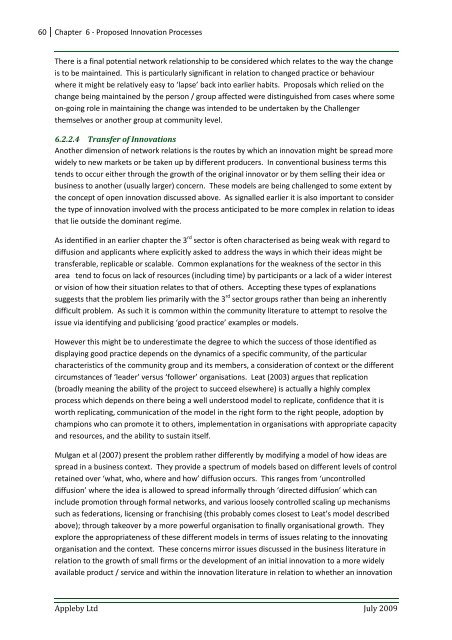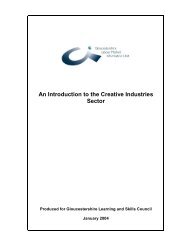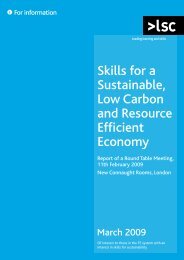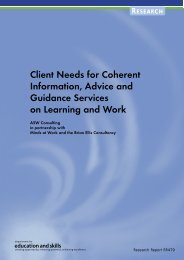Mapping the Big Green Challenge - The Skills & Learning ...
Mapping the Big Green Challenge - The Skills & Learning ...
Mapping the Big Green Challenge - The Skills & Learning ...
Create successful ePaper yourself
Turn your PDF publications into a flip-book with our unique Google optimized e-Paper software.
60 Chapter 6 - Proposed Innovation Processes<strong>The</strong>re is a final potential network relationship to be considered which relates to <strong>the</strong> way <strong>the</strong> changeis to be maintained. This is particularly significant in relation to changed practice or behaviourwhere it might be relatively easy to ‘lapse’ back into earlier habits. Proposals which relied on <strong>the</strong>change being maintained by <strong>the</strong> person / group affected were distinguished from cases where someon-going role in maintaining <strong>the</strong> change was intended to be undertaken by <strong>the</strong> <strong>Challenge</strong>r<strong>the</strong>mselves or ano<strong>the</strong>r group at community level.6.2.2.4 Transfer of InnovationsAno<strong>the</strong>r dimension of network relations is <strong>the</strong> routes by which an innovation might be spread morewidely to new markets or be taken up by different producers. In conventional business terms thistends to occur ei<strong>the</strong>r through <strong>the</strong> growth of <strong>the</strong> original innovator or by <strong>the</strong>m selling <strong>the</strong>ir idea orbusiness to ano<strong>the</strong>r (usually larger) concern. <strong>The</strong>se models are being challenged to some extent by<strong>the</strong> concept of open innovation discussed above. As signalled earlier it is also important to consider<strong>the</strong> type of innovation involved with <strong>the</strong> process anticipated to be more complex in relation to ideasthat lie outside <strong>the</strong> dominant regime.As identified in an earlier chapter <strong>the</strong> 3 rd sector is often characterised as being weak with regard todiffusion and applicants where explicitly asked to address <strong>the</strong> ways in which <strong>the</strong>ir ideas might betransferable, replicable or scalable. Common explanations for <strong>the</strong> weakness of <strong>the</strong> sector in thisarea tend to focus on lack of resources (including time) by participants or a lack of a wider interestor vision of how <strong>the</strong>ir situation relates to that of o<strong>the</strong>rs. Accepting <strong>the</strong>se types of explanationssuggests that <strong>the</strong> problem lies primarily with <strong>the</strong> 3 rd sector groups ra<strong>the</strong>r than being an inherentlydifficult problem. As such it is common within <strong>the</strong> community literature to attempt to resolve <strong>the</strong>issue via identifying and publicising ‘good practice’ examples or models.However this might be to underestimate <strong>the</strong> degree to which <strong>the</strong> success of those identified asdisplaying good practice depends on <strong>the</strong> dynamics of a specific community, of <strong>the</strong> particularcharacteristics of <strong>the</strong> community group and its members, a consideration of context or <strong>the</strong> differentcircumstances of ‘leader’ versus ‘follower’ organisations. Leat (2003) argues that replication(broadly meaning <strong>the</strong> ability of <strong>the</strong> project to succeed elsewhere) is actually a highly complexprocess which depends on <strong>the</strong>re being a well understood model to replicate, confidence that it isworth replicating, communication of <strong>the</strong> model in <strong>the</strong> right form to <strong>the</strong> right people, adoption bychampions who can promote it to o<strong>the</strong>rs, implementation in organisations with appropriate capacityand resources, and <strong>the</strong> ability to sustain itself.Mulgan et al (2007) present <strong>the</strong> problem ra<strong>the</strong>r differently by modifying a model of how ideas arespread in a business context. <strong>The</strong>y provide a spectrum of models based on different levels of controlretained over ‘what, who, where and how’ diffusion occurs. This ranges from ‘uncontrolleddiffusion’ where <strong>the</strong> idea is allowed to spread informally through ‘directed diffusion’ which caninclude promotion through formal networks, and various loosely controlled scaling up mechanismssuch as federations, licensing or franchising (this probably comes closest to Leat’s model describedabove); through takeover by a more powerful organisation to finally organisational growth. <strong>The</strong>yexplore <strong>the</strong> appropriateness of <strong>the</strong>se different models in terms of issues relating to <strong>the</strong> innovatingorganisation and <strong>the</strong> context. <strong>The</strong>se concerns mirror issues discussed in <strong>the</strong> business literature inrelation to <strong>the</strong> growth of small firms or <strong>the</strong> development of an initial innovation to a more widelyavailable product / service and within <strong>the</strong> innovation literature in relation to whe<strong>the</strong>r an innovationAppleby Ltd July 2009











